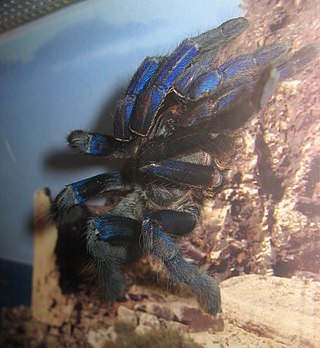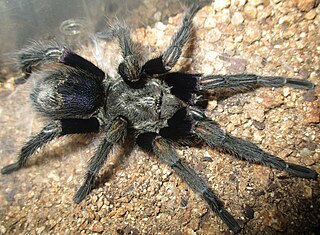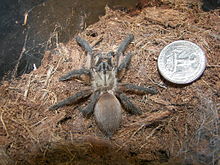
Ornithoctoninae is a subfamily of tarantulas found in Southeast Asia. It was first erected in 1895 by Reginald Innes Pocock based on the type specimen Ornithoctonus andersoni.

Barychelidae, also known as brushed trapdoor spiders, is a spider family with about 300 species in 42 genera. Most spiders in this family build trapdoor burrows. For example, the 20 millimetres (0.79 in) long Sipalolasma builds its burrow in rotted wood, with a hinged trapdoor at each end. The 10 millimetres (0.39 in) long Idioctis builds its burrow approximately 5 centimetres (2.0 in) deep, just below the high tide level, sealing the opening with a thin trapdoor.

Ceratogyrus is a genus of tarantulas found in southern Africa. They are commonly called horned baboons for the foveal horn found on the peltidium in some species.

Euathlus is a genus of South American tarantulas that was first described by Anton Ausserer in 1875. These spiders are medium sized and are usually found in high elevations in the Andes. It is a senior synonym of Paraphysa, and was formerly considered a senior synonym of Brachypelma, but this was later rejected.

Tarantulas comprise a group of large and often hairy spiders of the family Theraphosidae. As of August 2022, 1,040 species have been identified, with 156 genera. The term "tarantula" is usually used to describe members of the family Theraphosidae, although many other members of the same infraorder (Mygalomorphae) are commonly referred to as "tarantulas" or "false tarantulas". Some of the more common species have become popular in the exotic pet trade. Many New World species kept as pets have setae known as urticating hairs that can cause irritation to the skin, and in extreme cases, cause damage to the eyes.

Idiops is a genus of armored trapdoor spiders that was first described by Josef Anton Maximilian Perty in 1833. It is the type genus of the spurred trapdoor spiders, Idiopidae. Idiops is also the most species-rich genus of the family, and is found at widely separated locations in the Neotropics, Afrotropics, Indomalaya and the Middle East. Females live in tubular burrows lined with a thick layer of white silk. These typically have a D-shaped lid that fits into the entrance like a cork, and some burrows have two entrances. The lid may consist of mud, moss or lichen, which is bound below by a thick layer of silk. As in all genera of this family, the anterior lateral eyes (ALE) are situated near the clypeal margin, far in front of the remaining six eyes, which are arranged in a tight group. The males which are smaller in size, wander about or occasionally live in burrows. Like other mygalomorphs, they are relatively large and long-lived. Forest clearance and agricultural practices that loosen the soil and enhance erosion, besides soil removal for brick making have been pointed out as serious threats to some Indian species. Species ranges are poorly known – in India for instance, most species are known only from their type localities.
Scalidognathus is a genus of Asian armored trapdoor spiders that was first described by Ferdinand Anton Franz Karsch in 1892. Originally placed with the Ctenizidae, it was moved to the Idiopidae in 1985.

Hysterocrates is a genus of African tarantulas that was first described by Eugène Louis Simon in 1892.
Mascaraneus is a monotypic genus of African tarantulas containing the single species, Mascaraneus remotus. It was first described by R. C. Gallon in 2005, and is endemic to Mauritius.
Myostola is a spider genus in the family Theraphosidae (tarantulas), with the sole species Myostola occidentalis, found in Gabon and Cameroon.

The Stromatopelminae are a subfamily of tarantulas native to West Africa and part of Central Africa. The subfamily was first proposed by Günter Schmidt in 1993.

The Aviculariinae are a subfamily of spiders in the family Theraphosidae (tarantulas). They can be distinguished from other theraphosids by a number of characters. Their legs have no or few spines on the underside of the tibial and metatarsal joints of the legs. The last two leg joints have brushes of hairs (scopulae) that extend sideways, particularly on the front legs, giving them a spoon-like (spatulate) appearance. Females have two completely separated spermathecae.

Cyriopagopus is a genus of southeast Asian tarantulas found from Myanmar to the Philippines. As of March 2017, the genus includes species formerly placed in Haplopelma. It was first described by Eugène Louis Simon in 1887.
The Ischnocolinae are a problematic subfamily of tarantulas. In 1892, Eugène Simon based the group, which he noted was only weakly homogeneous, on the presence of divided tarsal scopulae. This feature was later considered to be plesiomorphic, and both morphological and molecular phylogenetic studies have shown that, as traditionally circumscribed, the subfamily is not monophyletic. A much more narrowly defined Ischnocolinae sensu stricto was proposed in 2014. One of the authors of that proposal subsequently said that no further taxonomic changes should be considered until there had been a more comprehensive sampling of the subfamily. As of January 2021, the status of the Ischnocolinae remains unresolved.

Chilobrachys is a genus of Asian tarantulas that was first described by Ferdinand Anton Franz Karsch in 1892. They are found in India, Myanmar, Malaysia, China, Vietnam, Thailand and Sri Lanka. They are usually medium or large-sized, and they can stridulate by using small spines present on the chelicerae.
Augacephalus is a genus of harpacterine theraphosid spiders. It has three species, all of which are found in Africa.
Tigidia is a genus of brushed trapdoor spiders first described by Eugène Simon in 1892.

Haploclastus is a genus of Indian tarantulas that was first described by Eugène Louis Simon in 1892. It is considered a senior synonym of Phlogiodes.

The Selenocosmiinae are a subfamily of tarantulas found throughout South-East Asia and Australia. This subfamily is defined by the presence of a lyra on the maxillae and strikers on the chelicerae, allowing these spiders to stridulate and produce a "hissing" sound. However some species within Phlogiellus may have secondary lost their lyra but retain their strikers. The monophyly of the subfamily has been only tested using genetic data with a handful of genera or species in a few studies. However, these studies found genera that had been previously placed in this subfamily were actual their own separate subfamily (Poecilotheria) and that Selenocosmiinae is most closely related to the Indian Thrigmopoeinae. As of 2021, Selenocosmiinae contains 11 genera.













